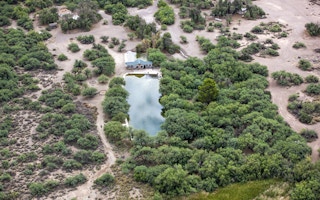A new FAO database released on Monday collects previously scattered and unharmonized land cover information from around the globe into one centralised database, marking a major improvement in information regarding the physical characteristics of the Earth’s surface.
Up to now, one of the major challenges to getting a good global overview of land cover - e.g. how much land is covered by croplands, trees or forests, bare soils, etc. - has been the fact that different countries and organisations go about identifying, measuring and recording such data in diverse ways.
But for FAO’s new Global Land Cover SHARE database (GLC-SHARE), data pulled from multiple sources and partners was quality-controlled and harmonised using internationally accepted definitions and standards, bringing a wealth of country-level information into one consolidated dataset spanning the entire planet.
“
It will be a valuable tool in assessing the sustainability of agriculture, and for supporting evidence based-sustainable rural development and land use policy contributing to reducing poverty, enabling of inclusive and efficient agricultural and food systems and increasing resilience of livelihoods
John Latham, FAO’s Land and Water Division
Applications of the new GLC-share database include monitoring of global land cover trends, evaluating the suitability of land for various uses, assessing the impact of climate change on food production, and land-use planning.
“A strong understanding of our planet’s land cover is essential to promoting sustainable land resources management - including agricultural production to feed a growing population - that makes efficient use of increasingly scarce natural resources yet safeguards the environment,” said John Latham, of FAO’s Land and Water Division. “This update to our understanding of the Earth’s land cover comes at a crucial time,” he added.
“It will be a valuable tool in assessing the sustainability of agriculture, and for supporting evidence based-sustainable rural development and land use policy contributing to reducing poverty, enabling of inclusive and efficient agricultural and food systems and increasing resilience of livelihoods. GLC-SHARE will also help us understand how climate change and climate variability are impacting key natural resources, as well as food production.”
A surging global population and growing demand for food pose major challenges for agriculture, which in the years to come will need to produce more food using fewer natural resources while at the same time coping with a changing climate. FAO estimates that world food production will need to increase by 60 per cent by 2050, for the most part on lands that are already being cultivated.
FAO’s new database includes eleven global land cover layers:artificial surfaces (which cover 0.6 per cent of the Earth’s surface) bare soils (15.2 per cent) croplands (12.6 per cent) grasslands (13.0 per cent) herbaceous vegetation (1.3 per cent) inland water bodies (2.6 per cent) mangroves (0.1 per cent) shrub-covered areas (9.5 per cent) snow and glaciers (9.7 per cent) sparse vegetation (7.7 per cent) tree-covered areas (27.7 per cent)










